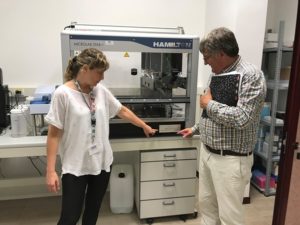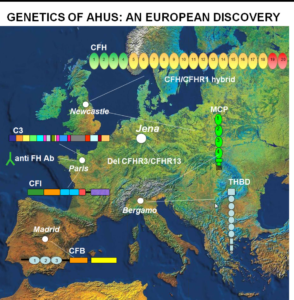Another webinar by ERKNet of interest to the aHUS community was held today. It was to be given by Dr Giuseppe Remuzzi but instead at the last moment one of his team , Dr Marina Noris stepped in to do it. The subject was “Unraveling the pathophysiology of HUS in light of recent discoveries on complement activation”
Giuseppe is a highly regarded researcher and has been so for many years. He founded a rare disease research centre near Bergamo in Italy when there was little interest in such research and included aHUS/HUS in its scope. The Centre was host to many of the earliest conferences about aHUS . It is now an established world class expert centre for aHUS.

Marina has become one of the foremost aHUS researchers in the world.

Dr Noris with Len Woodward of the aHUS alliance at the Research Centre in Bergamo during the whistle top tour of European aHUS Expert Centres ( read here)
The alliance registered to attend the webinar. Starting on time the talk proved to be an advanced and up to date learning opportunity about aHUS and the alternative pathway of Complement.
Beginning with describing Thrombotic Microangiopathies (TMAs) , of which aHUS is the one caused by dysregulation of the Complement System. aHUS has an incidence of 0.5 to 2 per million of the population ( which means between 4000 and 15000 new cases globally annually) and without treatment 80% of those patients would die or go into chronic kidney failure.
Marina introduced the components of the pathways of Complement focusing on the Alternative path and the creation of the C5 converteses which sets off the Membrane Attack Complex from a state of continuous “tickover”. Then spent time explaining the controls, in particular CFH and how in three ways its effectiveness to do its job is compromised.
- Because of inherited defects within the factor itself which although it might control at C3 level in blood fluid phase is not able to do so at capillary surface level when the MAC is very active.
- Hybrid defects caused by parts of CFH being replaced by Complement Factor H Related (CFHR) proteins of which there are five.
- Anti factor H auto-antibodies created to diminish performance of good CFH, which seems to happen when CFHR 1 and 3 are missing .
Marina continued with explanations of other control factors failures ( CFI and MCP components ) and when C3 gains too much function to exhaust controls.
She showed how most of the defects were discovered by European Research.

Marina then explained incomplete penetrance in aHUS families which put some family members at more risk than others. Common haplotypes play a part to put patients at more or less risk. It has also been found that people are more susceptible to aHUS if they have more than one Complement component with a mutation.
The talk finished off with illustrations of how effective eculizumab is but how its price at €460,000 per adult per year requires its use to be looked at. By tapering and withdrawing treatment when possible with safe monitoring , studies are in place to guide future use.
As with all ERKNet webinars they are recorded ,sound only , but with a complete set of slides used. This link here will take the viewer to the ERKNET past webinars website page where the recordings and slides will appear. It is well worth listening to ,and the slide cartoon used to illustrate how defective or compromised CFH does not work makes it very clear.

